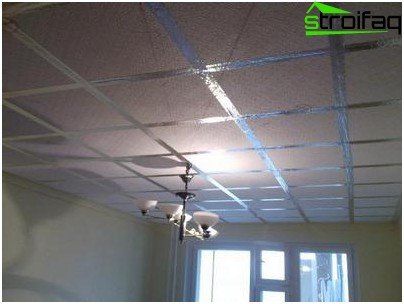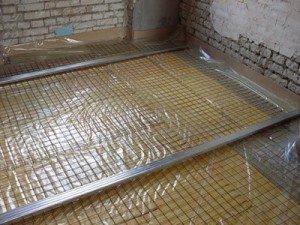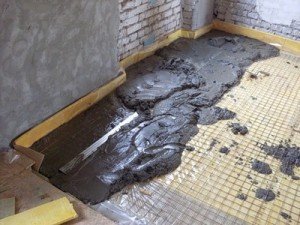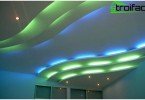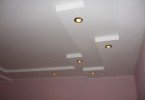How to make a soundproofing ceiling in an apartment with your own hands
The quality of life in your own apartment depends largely on the neighbors and if they are noisy, and always at the wrong time … What should I do – ask, curse, sort things out? You can try, but it is not always effective, and troublesome. And you will have to hear again and again a sofa, a crying child, piano lessons, a noisy party. But coming home tired, we most often want to stay in peace and silence. But there is a way out of this situation. Soundproofing the ceiling with your own hands will help get rid of annoying unnecessary sounds.
Content
- Types of indoor noise
- Soundproofing methods for ceilings
- Soundproofing Plasterboard Ceilings
- Suspended acoustic ceilings
- Noise isolation of a stretch ceiling
- Floating soundproof floors
Types of indoor noise
Noises arising indoors are of two types:
- Aerial. Such noises are generated as a result of air vibrations propagated by a source of sufficient power. They are transmitted through various slots, cracks and even through outlets (sound from the radio, TV, conversation between people).
- Structural. These are the noises arising as a result of mechanical action on the interroom partitions. Such noise can include driving nails, moving furniture, dropping a heavy object on the floor, drilling, etc. Since sound travels through solids at a speed of 12 times that of air, structural noise clearly differs and spreads over considerable distances. Therefore, when one of the tenants hammer a nail, all neighbors on the porch know about it.
Annoying excess noise can lead to loss of sleep, neurosis
There is only one way out – to make the room soundproofed. Soundproofing is necessary not only for walls, ceilings and partitions, but also for ceilings. This will reduce sound pressure and prevent the spread of noise..
Soundproofing methods for ceilings
Soundproofing ceilings is made in various ways. This can be sound insulation boards, heat-insulating compounds, suspended ceilings and other options.
Often, to improve sound insulation, the room is covered with foam sheets and then plastered. In fact, this method is ineffective. Polypropylene, polyethylene foam or cork do not sufficiently stop excess noise.
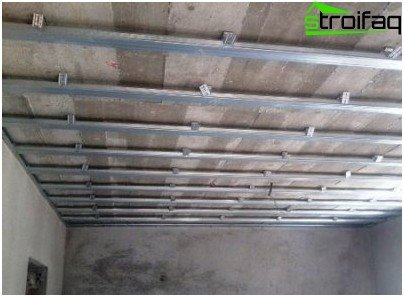
False ceilings combine with sound absorbing slabs
False ceilings can be combined with sound absorbing plates by fixing them to the base of the ceiling, but this requires a large ceiling height in the room. If the ceilings are low, then sound-absorbing plates are mounted directly on the ceiling, and this work is not easy and requires the observance of a certain technology, therefore, as a rule, specialists are invited to such work.
A high level of sound insulation is achieved using modern liquid sound and heat insulating compounds. Such materials not only protect the surface from the “bridges of cold” and dampness, but also retain sound well. According to its heat-insulating and sound-absorbing characteristics, a millimeter layer of this composition is equal to one brick laid in length.
Note. In houses built of brick or concrete structures, sound insulation of ceilings will be insufficient, it will be necessary to perform sound insulation of all surfaces of the premises.
Soundproofing Plasterboard Ceilings
This method of soundproofing ceilings is the most common among people who make repairs with their own hands. Installation of gypsum boards is easy and quick, for this you do not need to have construction skills. At the same time, various soundproofing materials can be used: polyurethane foam blocks, reed tiles, foam glass, cotton wool. The most environmentally friendly materials include coconut fiber and cork..
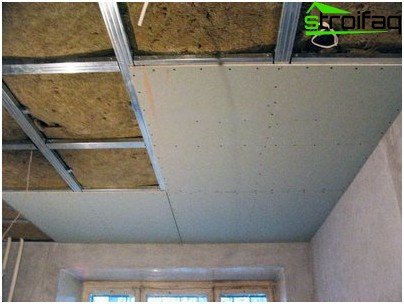
Soundproofing Drywall Ceiling
The process of soundproofing a plasterboard ceiling occurs in the following order:
- Using the building level along the perimeter of the walls, the front layout of the frame is marked.
- Special brackets are attached to the ceiling, then the frame will be attached to them. The pitch of the frame is from 0.6 to 1m (it all depends on the number of drywall sheets, their thickness and type of construction).
- Using a special glue, a membrane is glued to the ceiling.
- The frame is installed: with perpendicular installation – in increments of 50-60 cm, with parallel installation – 40 cm.
- Soundproofing material is glued between the carcass profiles to the membrane.
- Plasterboard panels are attached to the profiles of the frame, a sound reinforcing strip is laid at the joints. To avoid cracking of assembly joints, try to mount the end parts of drywall sheets to the location of the profiles.
- Using plaster or moisture-resistant mastic, joints between plasterboard sheets are sealed.
Suspended acoustic ceilings
Designed specifically to absorb indoor noise. In addition, acoustic suspended ceilings hide the unevenness of the ceiling base and have a very beautiful appearance.
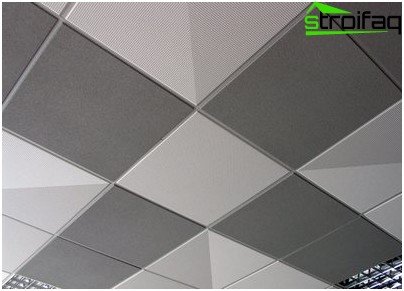
Acoustic suspended ceiling is specially designed for the effective absorption of sounds in the room
Installation of such a ceiling is not complicated and is quick:
- Markup is done.
- With the help of rails and suspensions, the structure is mounted.
- Soundproof slabs made of fireproof and moisture resistant material that absorb sound in the room and reduce echo (fiberglass or mineral wool) are placed in the formed cells..
Noise isolation of a stretch ceiling
Contrary to a widespread misconception, stretch ceilings have greater soundproofing properties than suspended. The explanation for this lies in the laws of acoustics: suspended ceilings appear as original resonators, while stretch ceilings, on the contrary, damp out sounds due to their soft texture.
- Soundproofing material is attached with screws or glue to the base ceiling. For this, special acoustic plates are used..
- Then, the ceiling structure is attached to the ceiling at a distance of about 10 cm from the layer of soundproofing material, electrical wiring is done.
- The canvas is stretched (before installation, it should lie down for a day in the room where the installation will be performed).
The sound insulation layer is prepared, the next step is canvas tension
Floating soundproof floors
Another effective way of soundproofing is the installation of a “floating” floor in the apartment from above. Of course, this simple technology can be applied in the case of good relations with neighbors from above, especially since it gives an amazing sound-absorbing effect.
Granular polyethylene foam is poured onto the floor, a sheet of fiberglass or technical cork is covered.
A concrete screed is made on the laid insulation layer, on which the main floor is then laid. If the insulating material is laid directly under the floor, the noise insulation will be less effective..
To improve sound insulation, elastic substrates can be installed on the floor of the upper apartment, which will suppress noise. It can be a rolled substrate with a polyethylene foam backing or a technical cork. Compounds based on polymer fibers or fiberglass are good at suppressing noise. This layout of the neighbor floor gives the most reliable sound insulation of your ceiling..
Soundproofing the ceiling will help you protect yourself from the noise of neighbors from above, and you will not hear their conversations, steps, loud music. As you can see, there are many ways to soundproof the ceiling, and which one to choose to turn your home into a quiet haven is up to you.



